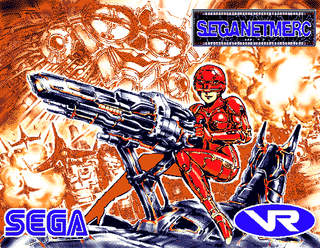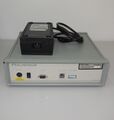Difference between revisions of "Dennou Senki Net Merc"
From Sega Retro
m (→Gameplay) |
m |
||
| Line 11: | Line 11: | ||
}} | }} | ||
}} | }} | ||
| − | {{sub-stub}}'''''{{PAGENAME}}'''''{{fileref|Becoming Virtual - Bodies, Technologies, Worlds (Thesis by Nicola Green, University of Canterbury, New Zealand, 1999).pdf|page=75}} (電脳戦記ネットマーク, Cyber Troopers | + | {{sub-stub}}'''''{{PAGENAME}}'''''{{fileref|Becoming Virtual - Bodies, Technologies, Worlds (Thesis by Nicola Green, University of Canterbury, New Zealand, 1999).pdf|page=75}} (電脳戦記ネットマーク, Cyber Troopers '''Net'''work '''Merc'''enary) is an [[arcade]] game developed by [[Sega]] with assistance from UK-based [[Virtuality]]. Utilising a [[Mega Visor Display]] headset, it is the only game created for the '''Sega Net Merc''' (セガ ネットマーク) system (a [[Sega Model 1]] arcade board adapted for virtual reality), so the two are often used interchangably. |
==Gameplay== | ==Gameplay== | ||
Revision as of 11:40, 31 May 2021
| Dennou Senki Net Merc | |||||||||
|---|---|---|---|---|---|---|---|---|---|
| System(s): Sega Model 1 | |||||||||
| Publisher: Sega | |||||||||
| Developer: Sega AM3[1], Virtuality | |||||||||
| Genre: Shoot-'em-up | |||||||||
| Number of players: 1 | |||||||||
|
This teeny-tiny article needs some work. You can help us by expanding it.
Dennou Senki Net Merc[2] (電脳戦記ネットマーク, Cyber Troopers Network Mercenary) is an arcade game developed by Sega with assistance from UK-based Virtuality. Utilising a Mega Visor Display headset, it is the only game created for the Sega Net Merc (セガ ネットマーク) system (a Sega Model 1 arcade board adapted for virtual reality), so the two are often used interchangably.
Contents
Gameplay
Dennou Senki Net Merc is an on-rails shoot-'em-up game, in which players use a large gun controller to fire at enemies. Being a virtual reality game, players are also given a VR headset (a "MVD" or "Mega Visor Display"[3], similar to those found in the VR-1), allowing for their head movements to be tracked in real time and therefore see a full 360 degree view of their surroundings.
Players are always stood facing in one direction behind the gun controller during gameplay. The complex nature of the system means that a member of staff was usually on hand to assist users with the headset.
The Sega Net Merc system consists of a Mega Visor Display being attached to a 3SPACE ISOTRAK II[4] head and motion tracker and a specialised cabinet. The 3SPACE ISOTRAK II was manufactured by Polhemus Inc.[5] a technology company specialised in motion tracking that was founded in 1969 by Bill Polhemus[6]. Originally known as Polhemus Navigation Sciences[7], it was based in Grand Rapids, Michigan, before moving in early 1971 to the town of Colchester, Vermont.
History
Development
Dennou Senki Net Merc was one of the results of a partnership between Sega and UK-based Virtuality, who were one of the biggest success stories of the early commercial virtual reality boom of the early 1990s. Despite their work on the 1000CS and 1000SD series being widely accepted by consumers, criticism was made over the rudimentary technology involved and the poor design quality of the head mounted displays utilised; the partnership sought to solve these issues.[8]
As evidenced by the likes of Virtua Racing and Virtua Fighter, the significantly more expensive Model 1 board could produce higher resolution graphics and more polygons than most PCs at the time, all while maintaining a 60FPS frame rate. The Net Merc project was a combination of Virtuality's previous VR technologies and Sega's once-cutting edge arcade board, with a partnership formed on the basis of this.
Alongside the VR-1 theme park attraction, the project was developed in the offices of Sega AM3, with two programmers (Andy Reece and Stephen Northcott, a former programmer at Incentive Software) and two artists from Virtuality in the UK collaborating with AM3 to create a new, slimmed down headset, resulting in the Mega Visor Display, one of the most advanced head mounted displays of its generation.[9]
Release
Shortly after the launch of VR-1 in July 1994 at Yokohama Joypolis, Dennou Senki Net Merc first appeared in public at the Amusement Machine Show 1994 the following month as TecWar,[10] before re-appearing at AOU Show 1995. It is thought to have changed its name to avoid potential conflicts with William Shatner's TekWar novels (and subsequent video game).
VR-1, which utilised the initial fruits of Sega's partnership with Virtuality, was generally regarded as a success.[9] However, by 1995 the relatively simplistic graphics generated by the Model 1 board (compared to say, the Sega Model 2 game Sega Rally Championship which was also on show at AOU 1995) were seemingly not well received.[11]
While 70 Net Merc machines made it into production, with the game performing well on location test at the Ikebukuro GiGO game centre,[12] most of these are not thought to have left Japan. A select few were imported to overseas venues ran by Sega, including Metropolis, SegaWorld London, and Sega Park Madrid.
Legacy
Despite using the acclaimed Mega Visor Display headset, Dennou Senki Net Merc is retrospectively not considered to have been as popular or influential as Virtuality's other works, both with Sega and without. Few cabinets are thought to still exist.
Magazine articles
- Main article: Dennou Senki Net Merc/Magazine articles.
Photo gallery
Video excerpt showing Dennou Senki Net Merc running (filmed on the Flight Deck[13][14] floor, of Sega World London), taken from episode #7 of the third season (1997) of BBC's documentary television series Connections
Polhemus 3SPACE ISOTRAK II[4] Dual Receiver Motion Tracker Front
Polhemus 3SPACE ISOTRAK II[4] Dual Receiver Motion Tracker Back
External Links
References
- ↑ 1.0 1.1 Sega Arcade History, Enterbrain, page 136
- ↑ File:Becoming Virtual - Bodies, Technologies, Worlds (Thesis by Nicola Green, University of Canterbury, New Zealand, 1999).pdf, page 75
- ↑ File:Becoming Virtual - Bodies, Technologies, Worlds (Thesis by Nicola Green, University of Canterbury, New Zealand, 1999).pdf, page 183
- ↑ 4.0 4.1 4.2 http://www.polhemus.com:80/isotrkds.htm (Wayback Machine: 1997-03-30 14:09)
- ↑ Press Release: 1996-08-05: Sega Selects Polhemus to Develop Next Generation Motion Capture System
- ↑ http://www.polhemus.com:80/AboutUs.htm (Wayback Machine: 2004-08-06 14:05)
- ↑ http://www.polhemus.com:80/genfaq.htm (Wayback Machine: 1998-07-04 01:50)
- ↑ https://www.gamebusiness.jp/article/2016/09/14/12597.html
- ↑ 9.0 9.1 https://www.vrfocus.com/2020/07/the-virtual-arena-blast-from-the-past-the-vr-1/
- ↑ Edge, "December 1994" (UK; 1994-10-27), page 12
- ↑ Edge, "May 1995" (UK; 1995-03-20), page 17
- ↑ http://www.system16.com/hardware.php?id=712
- ↑ http://tedsegablog.blogspot.com/2017/06/the-rise-and-fall-of-london-trocadero.html
- ↑ https://3.bp.blogspot.com/-IQO53Njw_qI/WdjMwqRsJWI/AAAAAAAAAaI/TaH5RcMm7c4wOFWYltpE-e7rAV380BPRwCLcBGAs/s1600/trocclosed6.jpg
| Mega Visor Display | |
|---|---|
| Hardware | Mega Visor Display | VR-1 | Sega Net Merc |
| Software | Space Mission | Planet Adventure | Dennou Senki Net Merc |






